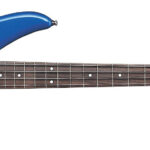Restringing your nylon-string guitar might seem daunting at first, but with a little guidance, it’s a simple process you can master. Whether you’re a beginner or just need a refresher, this guide will walk you through the steps to get your guitar sounding its best again. Let’s get those new nylon guitar strings on!
Step-by-Step Guide to Restringing Your Nylon-String Guitar
Here’s a straightforward method to string up your nylon-string guitar. Follow these steps for each string, one at a time, or remove all old strings and then proceed.
-
Prepare for the New String: Take your new nylon guitar string. For the E string (6th string, thickest), locate the correct string. Nylon strings are usually packaged individually and labeled.
-
Bridge Attachment: Thread one end of the new string through the bridge hole from the back of the guitar, towards the soundhole. Pull it through a few inches. Now, tie a simple knot at the end you pulled through, ensuring the knot is large enough not to slip back through the hole. A figure-eight knot works well, or simply looping the string end around itself a couple of times.
-
Tuning Peg Threading: Guide the other end of the string up to the headstock. Locate the correct tuning peg for the E string. Pass the string through the hole in the tuning peg.
-
Winding the String: Pull the string through the tuning peg hole, leaving enough slack to wind around the post several times – about 3-4 inches is usually sufficient. Begin winding the tuning peg to tighten the string. As you wind, guide the string downwards around the tuning post, layering the string neatly. Keep some tension on the string as you wind to ensure it coils smoothly and tightly. Generally, you’ll wind the string outwards, but if winding inwards helps avoid headstock contact, that’s also acceptable.
-
Snip Excess String: Once the string is tuned close to pitch, trim the excess string beyond the tuning peg. Leave a little bit of extra string – don’t cut too close to the hole.
-
Repeat for All Strings: Follow steps 1-5 for the remaining five nylon guitar strings. Work your way through each string – A, D, G, B, and high E.
Important Aspects When Restringing with Nylon Strings
Headstock Considerations
As the string runs from the nut to the tuning peg, it might sometimes touch or press against the headstock wood. Ideally, we want to minimize this. While winding outwards on the tuning post is common, if winding inwards prevents string contact with the headstock, it’s a good idea to wind in that direction. Sometimes, headstock contact is unavoidable. Aim to prevent it when possible, but don’t worry excessively if it can’t be completely eliminated.
Tuning Stability and Stretching Nylon Strings
Nylon strings are known for needing a settling-in period. They tend to stretch after installation, causing the tuning to drop. To speed up this process and enhance tuning stability, stretch your new nylon strings after stringing. Gently pull each string along its length with your thumb and fingers. You can also give a firm but gentle tug to remove slack at the bridge and tuning post. Avoid excessive force, but a good stretch will significantly help them settle in faster. You might need to repeat this stretching process a couple of times as the strings settle. Regular tuning is essential in the initial period after restringing with new nylon strings.


